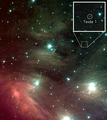Teide 1
Teide 1 was the first brown dwarf to be verified, in 1995.[6] It is located in the Pleiades open star cluster, approximately 400 light-years (120 pc) from Earth.
 Estimated relative size of the planet Jupiter and the brown dwarfs WISE 1828+2650, Gliese 229B, and Teide 1 compared to the Sun and a red dwarf. Credit: MPIA/V. Joergens. | |
| Observation data Epoch J2000 Equinox J2000 | |
|---|---|
| Constellation | Taurus |
| Right ascension | 3h 47m 17.925s[1] |
| Declination | +24° 22′ 31.71″[1] |
| Characteristics | |
| Spectral type | M8[2] |
| Apparent magnitude (J) | 16.215[1] |
| Apparent magnitude (H) | 15.591[1] |
| Apparent magnitude (K) | 15.096[1] |
| Astrometry | |
| Proper motion (μ) | RA: 21.40[2] mas/yr Dec.: -42.73[2] mas/yr |
| Parallax (π) | 8.40 mas |
| Distance | 400 ly (120 pc) |
| Details | |
| Mass | 57 ± 15[3] MJup |
| Radius | 3.78[3] RJup |
| Luminosity | 0.0008–0.0005[4] L☉ |
| Surface gravity (log g) | 6.6 cgs |
| Temperature | 2,600 ± 150[5] K |
| Age | 0.12 Gyr |
| Other designations | |
| Database references | |
| SIMBAD | data |
This object is more massive than a planet (57 ± 15 MJ),[5] but less massive than a star (0.0544 MSun). The radius of the brown dwarf is four times that of Jupiter. Its surface temperature is 2,600 ± 150 K,[5] which is about half that of the Sun. Its luminosity is 0.08–0.05% of that of the Sun.[4] Its age is only 120 million years compared to the Sun's age of 4.68 billion years.
Discovery
Teide 1 is detected by Rafael Rebolo López, María R. Zapatero-Osorio and Eduardo L. Martín on optical images obtained, in January 1994, with the 0.80 meter diameter telescope (IAC-80) from the Institut d ' Canary astrophysics located at the Teide Observatory on the island of Tenerife. Its cold nature was confirmed in December 1994 with the William Herschel telescope (WHT) of the Roque de los Muchachos observatory in La Palma. It is then the coldest of the known objects. On May 22, 1995, the article reporting his discovery was submitted to the journal Nature, which published it on September 14, 1995. Meanwhile, a similar object, Calar 3, was discovered. The brown dwarf nature of Teide 1 and Calar 3 was confirmed in 1996 following spectroscopic observations with the 10-meter diameter telescope of the W. M. Keck observatory of Mauna Kea on the island of Hawaii.
Characteristics
Teide 1 is a brown dwarf of spectral type M8 whose luminosity (log L / L☉) is approximately -3.24 ± 0.04 dex and the effective temperature is approximately 2 584 ± 100 K. Its mass is approximately 0.052 solar mass.
It is barely 120 million years old, and its surface temperature is estimated at around 2,600 Kelvin.
Gallery
 Teide 1 in the Pleiades as seen by the Spitzer Space Telescope.
Teide 1 in the Pleiades as seen by the Spitzer Space Telescope.
References
- Cutri, R. M.; et al. (2003). "2MASS All-Sky Catalog of Point Sources". VizieR On-line Data Catalog. Bibcode:2003yCat.2246....0C.
- "2MASS J03471792+2422317". SIMBAD. Centre de données astronomiques de Strasbourg.
- "All Exoplanets". Exoplanet Kyoto.
- Brown dwarfs in the Pleiades cluster confirmed by the lithium test
- Mid-IR Observations of the Pleiades Brown Dwarfs Teide 1 & Calar 3 (Leech 2000)
- Rebolo, Rafael (2014), "Teide 1 and the Discovery of Brown Dwarfs", in Joergens, Viki (ed.), 50 Years of Brown Dwarfs - From Prediction to Discovery to Forefront of Research, Astrophysics and Space Science Library, 401, Springer, pp. 25–50, doi:10.1007/978-3-319-01162-2_4, ISBN 978-3-319-01162-2
External links
- Walter Myers (1995). "Teide 1". Archived from the original on 2009-05-02.
- http://www.astro-tom.com/technical_data/magnitude_scale.htm